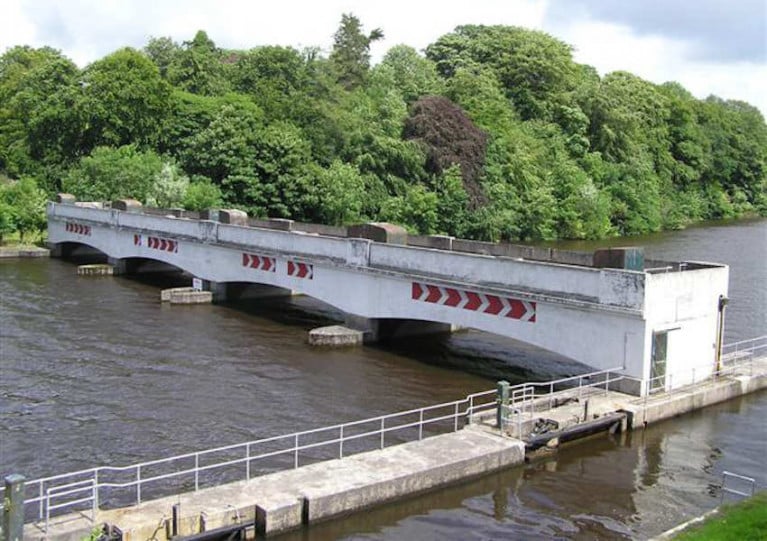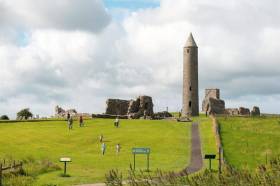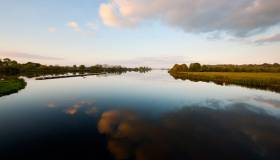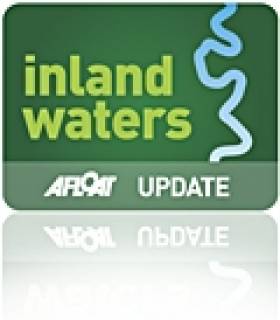Displaying items by tag: Erne System
All 16 locks on the Shannon-Erne Waterway will be out of service from today, Friday 24 December to Monday 3 January inclusive.
No lock passage by boat will be possible during this period. Normal service will resume at 9am on Tuesday 4 January.
Waterways Ireland adds that the service blocks at Aghalane and Haughton's Shore are closed until Monday 14 March. The service blocks at Ballyconnell, Ballinamore, Keshcarrigan and Leitrim shall remain open.
All associated land-based and water-based Blueway trails shall remain open, the cross-border body for Ireland’s inland waterways confirms.
In other updates: on the Erne System, Bellanaleck slipway is closed until further notice, while on the Shannon Navigation, Clarendon Lock in Co Roscommon will reopen to navigation on Tuesday 4 January following works in preparation for lock gate replacement, as previously reported on Afloat.ie.
Upcoming Inspection & Repair Works on Erne System
Inspections and repairs will be taking place on the Erne System later this month, according to Waterways Ireland.
On Upper Lough Erne, inspection work on the underside of Lady Brooke Bridge in Co Fermanagh will begin next Monday 11 October, continuing until Friday 22 October.
Pontoons will be in used to carry out the inspections and the bridge will be partially closed off to vessels during this period.
Masters of Vessels and waterways users are also advised that Corradillar Slipway and jetty will be used for assembly of the pontoons on 11 October and for disassembling the pontoons on 22 October.
Elsewhere, on Lower Lough Erne, major works will be taking place at Portora Lock gates outside Enniskillen on Thursday 14 and Friday 15 October.
The lock gates will be closed over these two days, from 8am on the Thursday to 7pm on the Friday.
Water Levels Reducing on Lower Lough Erne From This Weekend
Waterways Ireland confirms it has been advised by DfI Rivers in Northern Ireland that users of the Erne System can expect reducing water levels throughout the navigation from this weekend.
It follows from the planned lowering of water levels on Lower Lough Erne from this Friday 1 October to a minimum of 149 feet (above Poolbeg Ordnance datum) in anticipation of increased rain during autumn and winter, as previously reported on Afloat.ie.
If water levels do fall, masters of vessels on the inland waterways of the Erne System should be aware of the following:
- Navigation — To reduce the risk of grounding, masters should navigate on or near the centreline of the channel, avoid short cutting in dog-legged channels and navigating too close to navigation markers.
- Mooring of Vessels — Masters should be aware that water levels may change rapidly and that mooring lines will require adjustment therefore these should be checked regularly.
Shannon & Erne Boaters Advised of Winter Tree Cutting & Low Water Levels
Waterways Ireland advises all masters of vessels and users of the Shannon-Erne Waterway that tree trimming and hedge cutting will be carried out at various locations on these inland waterways during the autumn/winter period from this month until next February.
During this operation, floating pontoons will be located on the water with mechanical plant operating. Plant machinery will also be in operation along the banks of the waterway.
Masters of vessels will be advised by Waterways Ireland staff when making a passage.
In addition to this, Waterways Ireland says it anticipates DfI Rivers in Northern Ireland will advise that from 1 October, in keeping with water level management protocols, users of the Erne System can expect reducing water levels throughout the navigation.
Water levels on Lower Lough Erne are drawn down annually, weather permitting, to a minimum of 149 feet (above Poolbeg Ordnance Datum) in anticipation of increased precipitation during autumn and winter.
If water levels do fall, masters should be aware of the following:
- Navigation — To reduce the risk of grounding, masters should navigate on or near the centreline of the channel, avoid short-cutting in dog-legged channels and navigating too close to navigation markers.
- Mooring of Vessels — Masters should be aware that water levels may change rapidly and that mooring lines will require adjustment. Therefore mooring lines should be checked regularly.
Waterways Ireland has issued a number of updates for inland waterways users on the Erne System, Grand and Royal Canals and Barrow Navigation.
On the Erne System, the Galloon Bridge refurbishment project southwest of Newtownbutler will commence next Monday 23 August.
Vessels will not be permitted to navigate under the bridge at Galloon due to these works, which are expected to continue for 16 weeks.
In addition, the Carrybridge jetty and slipway will be closed for five days from Monday 23 to Friday 27 August for the realignment of jetty fingers. The electrical supply to bollards and pump-out will be turned off during this period.
On the Grand Canal, low water levels are being experienced on both the main line and Barrow Line, which are currently 300mm down on normal levels.
Masters of vessels are advised to proceed with additional caution and to contact the relevant water patroller for latest advice and assistance.
On the Royal Canal, canoe polo events will take place in the Kilcock Harbour area this Friday 20 August.
Waterways Ireland requests that the polo pitch areas and harbour be kept clear of all vessels to facilitate the events, and that masters of vessels comply with instructions from marshals.
Meanwhile, on the Barrow Navigation masters and owners are advised that Clashganny Lock is now fully operational following its temporary closure for essential repairs.
Waterways Ireland Gives Update on Restrictions Regarding Navigations in Northern Ireland
Following the recent reopening of inland waterways in the Republic, Waterways Ireland has given an update for all masters of vessels and water users on the Erne System, the Shannon-Erne Waterway (within Northern Ireland) and the Lower Bann Navigation.
In line with guidance provided by the Northern Ireland Executive, from this coming Monday 10 May all service blocks will reopen on these navigations.
On the Erne System and the portion of the Shannon-Erne within Northern Ireland,, pump-out facilities are available and local area access to jetties and moorings will be available in according with NI Executive guidance. All locks will also reopen on the Shannon-Erne.
On the Lower Bann, service blocks will reopen on Wednesday 12 May, with local area access to jetties and moorings as previously noted.
Portna, Movanagher and Cutts locks will also reopen on Wednesday. However, Toome Lock remains out of operation until Friday 28 May for works, and Carnroe Lock is closed until further notes pending ongoing engineering investigations.
Waterways Ireland reminds users when on jetties to be aware of others; wait or move aside to allow others to pass at a safe distance.
“We will continually review such measures in light of direction and advice from Government and health professionals,” the cross-border body adds.
Erne System: Portora Lock Closure for Maintenance This Week
Waterways Ireland advises that Portora Lock on the Erne System near Enniskillen will be closed to boat traffic on Tuesday 19 and Wednesday 20 January to accommodate essential maintenance works to the lock gates.
Masters of vessels on this inland waterway are asked to heed all instructions from safety personnel who will be in the area.
‘Pilgrim Way’ Along Shannon & Erne Systems Is In The Works
A series of consultative workshops on the feasibility of an iconic Pilgrim Way between the Shannon Navigation and Erne System took place earlier this month.
In late 2018, West Limerick Resources in partnership with Waterways Ireland and 13 local development companies (LDCs) and associated local authorities commissioned SLR Consulting and Alan Hill Tourism Development to investigate the feasibility of developing a 350km cross-border Pilgrim Way along the inland waterways.
The area under consideration is a 20km-wide corridor which uncovers a unique and vast pilgrim heritage on and along the inland waterways, from the Shannon estuary in Co Kerry northwards through the Shannon Navigation, Shannon-Erne Waterway, and Erne System in Co Fermanagh to Co Donegal.
The aim is to develop an iconic international ‘Pilgrim Way’ based on the rich early Christian and Viking heritage of the Early Medieval period in Ireland.
Well known ecclesiastical sites include Scattery Island, Iniscealtra (Holy Island, Clare), Clonmacnoise (Offaly), Quaker Island (Lough Ree), Boyle Abbey (Roscommon), Devenish Island (Lough Erne) and the iconic pilgrimage site at Lough Derg (St Patrick’s) in Donegal, among others.
Many more, lesser known sites are included in the overall analysis for a total of more than 100 sites in total. Waterways Ireland has more information about the project.
#InlandWaters - Waterways Ireland advises that the electricity supply to power pedestals and the supply of water to taps on public moorings on the Shannon Navigation will soon be disconnected for the winter period.
The move is being made for environmental reasons and to reduce maintenance costs. Services will be restored prior to the commencement of the 2019 boating season.
Shore power supply at the Round ‘O’ and Carrybridge public moorings on the Erne System, as well was water supply to taps throughout that system, was already disconnected or winter as of Wednesday 7 November.
MARINE NOTICE
No. 76 of 2013
ERNE NAVIGATION
UPPER LOUGH ERNE
TEMPORARY CLOSURE OF PUBLIC JETTY
Derryvore
Trial Bay
Waterways Ireland wishes to advise masters and owners that the mooring jetty at the above location has been temporarily closed to the public to facilitate emergency repair works.
Waterways Ireland apologises for any inconvenience caused during these works.
Charles Lawn
Inspector of Navigation
25 Jun 2013
Tel: 00 353 (0)90 6494232
Fax : 00 353 (0) 6494147
































































